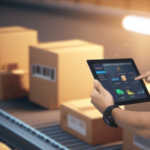
Choosing the Right eCommerce Platform for B2B Selling
April 12, 2023
Critical Components of Warehouse Management Systems?
October 13, 2023
What is composable commerce?
Composable commerce is a modern approach to e-commerce architecture that allows businesses to customize and assemble various components to create a tailored and flexible online shopping experience. Unlike traditional monolithic e-commerce platforms, which are rigid and come with fixed functionalities, composable commerce is built on the principles of modularity and flexibility. This approach leverages a combination of APIs (Application Programming Interfaces), microservices, and headless commerce to enable businesses to choose and integrate the best-of-breed solutions for different aspects of their e-commerce operations.
Key Features of Composable Commerce
- Modularity: Components of the e-commerce system are separate and can be developed, deployed, and managed independently.
- Flexibility: Businesses can select and combine different technologies and services that best meet their specific needs.
- Scalability: Systems can scale more efficiently as each component can be scaled independently based on demand.
- Agility: Faster adaptation to market changes and customer demands due to the ease of swapping out and upgrading individual components.
- Customization: Greater ability to create unique and personalized customer experiences by integrating various specialized services.
Components of Composable Commerce
- Headless CMS: A content management system that decouples the front end from the back end, allowing content to be delivered via APIs to any device or platform.
- Microservices: Small, independently deployable services that perform specific business functions, such as payment processing, inventory management, or customer reviews.
- APIs: Interfaces that allow different software applications to communicate with each other, enabling the integration of various services and platforms.
- DevOps and Automation: Practices and tools that support continuous integration, continuous delivery, and automation to ensure smooth and efficient deployment of new features and updates.
Benefits of Composable Commerce
- Enhanced Customer Experience: Ability to quickly implement and iterate on new features that improve user engagement and satisfaction.
- Cost Efficiency: Pay for only the components and services that are needed, potentially reducing overall costs.
- Future-Proofing: Easier to integrate emerging technologies and adapt to new trends without overhauling the entire system.
- Operational Efficiency: Streamlined operations with the ability to optimize and manage each component separately.
Example Use Cases
- Retailers: Can create highly customized and responsive online stores by integrating various best-in-class solutions for product recommendations, search, and checkout processes.
- B2B E-commerce: Companies can tailor their e-commerce platforms to meet complex purchasing processes and unique business needs by assembling different services for quoting, contract management, and customer support.
- Marketplaces: Operators can build and expand their platforms by incorporating various third-party services for payments, logistics, and user authentication.
For more detailed information on composable commerce and how it works, you can visit https://commercelab.com.tr/





